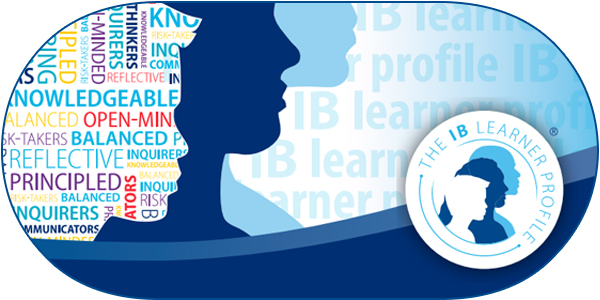The accelerated adoption of artificial intelligence, generative AI, and large language models and their widespread implementation across platforms, has grabbed our attention.
Reactions to the developments of AI have been diverse, from excitement to disbelief. While some see AI and its tools as an opportunity, others view it as a potential threat to the traditional education system.
A mix of interest, worry, and hope seems to fill many of the conversations in schools.
In this context, the question schools should be asking is: “What is the added value of school in a world where AI becomes prominent and accessible to all 24/7?”
A unique aspect of the IB learner profile is that, in many ways, the above question is addressed by the learner profile’s attributes.

These contain dispositions and approaches that support agility, reflection, and curiosity. In turn this creates important connections for learners to develop the skills, knowledge, and values to navigate the accelerated adoption of AI and the unpredictability around its growth.
Challenges and opportunities of AI
AI, generative AI and large language models are challenging many of the approaches of teaching and learning. With these developments come opportunities for access to information, real-world problem-solving, creativity, time-saving tools, and interdisciplinary learning.
At the same time, questions arise about ethics, bias, misinformation, manipulation, loss of originality, ownership, and attribution.
If many of the AI algorithms independently make complex decisions without people knowing how they arrived at those decisions, this lack of transparency makes it difficult to understand and address potential biases or errors. The concerns around AI’s lack of transparency increases the challenges these tools bring to a school setting.
Developing future-ready students with the IB learner profile
IB World Schools and educators over the years have developed an immense amount of expertise and created learning experiences to support students and guide the teaching and learning with the 10 IB learner profile attributes:
- knowledgeable
- thinkers
- inquirers
- communicators
- principled
- open-minded
- caring
- risk-taking
- balanced
- reflective
Linking the IB Learner profiles with AI offers educators an opportunity to integrate and use AI tools with an open mind. This open-mindedness doesn’t mean we shouldn’t be cautious, thoughtful, and reflective. Instead, it allows us to adopt potential opportunities while being mindful of the implications.
Exploring the potential of AI, generative AI and large language models with the IB learner profile attributes provides many learning opportunities.
The ways in which the IB learner profile attributes of knowledgeable and thinkers can support the responsible and effective adoption of AI are alluded to above.
Below I provide a short commentary on how educators can embrace the remaining attributes as they help students navigate the complex world of AI.
Inquirers
As inquirers, educators can explore the complexities of AI, modeling evaluation to highlight the importance of self-directed learning. As educators collaborate in creating activities with colleagues using AI tools, this can help nurture critical thinking and transdisciplinary connections between different subjects.
Communicators
By integrating AI driven scenarios, discussion prompts, real world case studies and role playing exercises, educators can support the growth of their students’ communication skills.
These AI enhanced activities not only grab the students’ attention but also provide them with practical experiences that reflect real life situations, giving them an opportunity to develop a deeper understanding of how to navigate different communications contexts and work in collaborative settings.
By facilitating these approaches, educators mentor their students with important current skills to manage a digitally driven world while creating an environment where learning remains relevant and authentic.
Principled
Educators can facilitate activities to help students understand the significance of integrity, biases and racism through the use of AI tools to delve into matters of ethics, diversity, equity and fairness.
One example would be to analyze text and images from different voices in media outlets to uncover hidden biases. The students use the AI tools to see how hidden biases might be used in the local, national or international media. This activity gives students an opportunity to develop an understanding of the importance of media literacy skills and being critical thinkers of media in their local, national and international context.
Open-minded
With an open-minded approach, educators can build activities that guide students to use AI tools to explore different perspectives and voices. This could involve using AI-generated content to analyze different articles from newspapers and magazines on current events, exposing them to different viewpoints or historical events from different perspectives and cultural lenses. Students are then provided with opportunities to interact with a variety of viewpoints and experiences, enhancing their critical thinking skills.
Caring
As educators, we can model the use of AI tools to emphasize the importance of caring, empathy, compassion, and respect. By leveraging AI tools, activities can be created with simulations and case studies that explore social issues and their impact on local and global communities.
For example, an educator introduces an AI simulation based on real world case studies linked to a social issue connected to the unit or lesson they are focusing on. Through these simulations, supported by teacher generated questions, prompts or activities, students are exposed to the challenges, tensions and complexities of the social issue. This process gives them the experience to read, listen, and watch how individuals and local communities from diverse backgrounds solve this social issue in the lesson.
Risk-taking
Engaging in the learning process, interacting, trying out, and exploring the use of AI tools as educators is an effective way to model risk-taking. Students experiencing this with activities guided by educators will develop confidence when navigating the uncertainties of AI tools.
Balanced
Recognizing the importance of balance and well-being, educators can mentor and help students explore different ways to understand their social, physical, and emotional well-being. This is very important as the use of AI-generated platforms, tools, and experiences become more prominent and are capturing our attention constantly throughout the day.
Reflective
In conclusion, as reflective practitioners, it is essential for school leaders to deliberately carve out the necessary space, allocate time, and provide purposeful professional development to support educators in this journey of AI cohabitation. This ensures that each of us can mentor, model, and guide students of all ages through experiences, activities, and learning pathways. This deliberate integration of AI tools in the learning process is a vital step in cohabiting with AI as equal partners.
John Mikton is the Primary Technology for Learning Coordinator at International School of Geneva – La Châtaigneraie, a trainer/course designer at the Principals’ Training Center and Teacher Training Center and a coach at Farai Education Group. He was a recipient of the Edruptors ISC Research Award 2021 and 2022.
John has 29 years’ experience as an educator in education and media technology in international schools (Africa, Asia and Europe), of which 18 years in school leadership as an IT director, director of elearning, head of education and media technology and deputy principal.
Blog: https://beyonddigital.org
Podcast: https://www.theinternationalschoolspodcast.com/
X: @jmikton
Linkedin: https://ch.linkedin.com/in/jmikton

